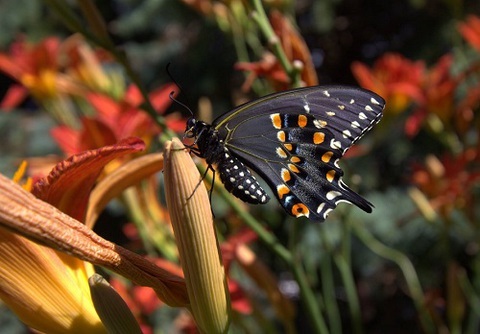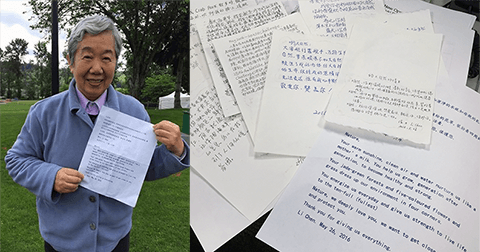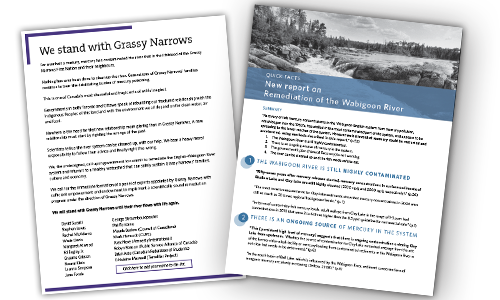David Suzuki's Blog, page 35
June 6, 2016
Canada's Oceans Need Your Support
How to turn your yard into a pollinator haven

Butterflies and hummingbirds share many nectar flowers, so efforts to lure one may attract both. (Credit: Theresa Hannah via Instagram)
Whether you have a small plot in the city or a few country acres, you can create a welcome space for important pollinators such as butterflies, hummingbirds and bees. Creating and restoring pollinator habitat and gardening pesticide-free helps offset what's being destroyed by development, roadside mowing or wetland drainage.
How to attract butterflies
Choose native flowers and shrubs. Butterflies need nectar plants for food and host plants to lay their eggs.
Tiger swallowtails choose nectar plants such as lilacs or bee balm; nearby willow, alder, or apple trees can host larva
Painted ladies choose nectar plants such as aster, cosmos or zinnia; host plants include thistle, mallow or hollyhock
Monarchs choose nectar plants such as milkweed, lilac, goldenrod and cosmos; the milkweed family are the monarchs' only host plants
To attract butterflies like the red admiral, tiger swallowtail and mourning cloak, you can also set up a nectar feeder using a solution of one part sugar to 18 parts water.
Butterfly facts:
Sunny days are best for butterfly watching -- they're active from about 10 a.m. to 3 p.m.
Some individual butterflies live only a week, but the flight season for a species may be more than a month -- the migrating monarch "super generation" may live for several months
In Canada, butterfly season runs from March through October
Females are slightly larger than males -- because she carries the eggs!
Bonus: Butterflies and hummingbirds share many nectar flowers, so efforts to lure one may attract both
How to attract hummingbirds
Hummingbirds are guided by their eyes and many red-coloured flowers provide good sources of nectar.
Try perennials like red or purple hollyhock, pink or red coral bells, bee balm, summer phlox or sage. Annuals that attract hummingbirds include begonias, cosmos, geranium and petunias. And don't forget shrubs and vines like hibiscus, honeysuckle and flowering currant. These plants prefer full sun exposure with shelter from strong winds.
Don't see much action the first season? Enjoy the flowers and wait a year.
Why plant sunflowers?
Sunflowers' height makes them beacons for pollinators. They're also rich sources of nectar and pollen for honeybees, bumblebees and other wild bee species, butterflies and other beneficial insects. Leave the flower in the garden as a natural fall and winter bird feeder.
Plant sunflowers in your food garden to lure important insects and improve pollination for fruits and vegetables. Get kids involved! The seeds are big -- easy for tiny hands. Push each seed two centimetres (one inch) into the soil. Big varieties need to be spaced three to five feet apart, but tiny ones will grow one foot apart (or one plant per three-gallon container).
Not all sunflowers are tall. Choose dwarf varieties, like music box (grows a few feet) for raised beds or in large containers, like half-barrels. For small spaces, choose tiny suntastic, which reaches about 30 centimetres (12 inches) tall, doesn't produce edible sunflower seeds, but adds colour to patio containers.
Seeds are ready to harvest when birds make frequent visits. Seeds from large sunflower species contain a substantial amount of oil -- much loved by chickadees!
How to help bumblebees There are about 250 species of bumblebees and they all need help. Most common species prefer dry, dark places. Your yard is probably home to a few types of bumblebee nests -- some can contain up to 400 bees!
There are three kinds of bumblebees:
Underground nesters like abandoned mouse holes, under garden sheds and in compost heaps.
Ground-dwelling bumblebees will nest in a compost pile -- some love the heat.
Above-ground bumblebees will take over any bird house you didn't clean out. They also make nests in thick grass and in tree cavities.
In addition to pollinating wild plants and food plants like tomatoes and blueberries, bumblebees that nest in the ground benefit your garden by:
Improving soil quality
Increasing water movement around plant roots
Mixing up soil nutrients
How to make a bee bath
Bees are busy. So they get thirsty! But like those other beneficial insects, ladybugs, bees are crash landers. Open water -- a creek, pond, even a bird bath -- puts bees at risk for drowning or being caught by predators. So make a bee watering hole.
Place a shallow plate in your yard at ground level where you've noticed bee activity. Add a few rocks to create landing pads or islands. Add fresh water but don't submerge the stones. You won't encourage mosquito larvae if you keep the water level low. And it's okay if the water evaporates. Refill your bee bath as needed.
Enjoy the buzzing, flittering activity knowing you're supporting important creatures we humans need to survive!
Sincerely,
Lindsay Coulter, a fellow Queen of Green
Hey! Want more DSF? Join David Suzuki on Facebook

June 2, 2016
Auditor-general opens investigation of B.C.'s controversial grizzly bear trophy hunt
The David Suzuki Foundation welcomes the B.C. auditor-general's decision to investigate the provincial government's management of grizzly populations, including its controversial trophy hunt.
"We hope this investigation will answer troubling questions we've raised about failed government policy that is allowing trophy hunters to kill too many grizzlies," said the Foundation's director-general for Ontario and Northern Canada, Faisal Moola.
The David Suzuki Foundation and the University of Victoria Environmental Law Centre requested the investigation after providing the auditor-general with a scientific study showing that B.C.'s approach to grizzly bear management is failing to protect this iconic Canadian animal. The study by scientists from Raincoast Conservation Foundation, Simon Fraser University, University of Victoria and the Hakai Institute was published in the peer-reviewed journal PLOS ONE and analyzed 35 years of grizzly bear mortality data in the province. It concluded that the provincial government is failing to keep kills below its own upper targets for bears killed by humans, and that government limits on bear mortality are regularly being exceeded in management areas throughout B.C. due to the trophy hunt.
The findings suggest the B.C. government is falling short on its duty to protect grizzlies, which are legally considered a public resource and are facing threats from logging, mining and oil and gas development, as well as direct morality from the trophy hunt and conflicts with people.
"The current hunt subjects grizzly populations to considerable risk. Substantial overkills have occurred repeatedly and might be worse than thought because of the many unaddressed unknowns in management," said Kyle Artelle, a biologist with Raincoast Conservation Foundation.
Grizzlies are important to the ecological, cultural and economic health of the province, and British Columbians deserve to know the facts about how they are being managed and whether government policy is putting the species at risk. "Decisions to expand the hunt in 2013 ran counter to our conclusions, casting doubt on the assertion that this is a science-based hunt," Artelle said, referring to a follow-up publication in the journal Science which criticized the decision to expand the hunt.
Approximately 300 grizzlies are killed each year in the province's annual trophy hunt. Grizzlies have also been eliminated from roughly 18 per cent of their original habitat in B.C. because of human impacts on habitat and other pressures. At least nine grizzly sub-populations in the province, including the North Cascades grizzly population east of Vancouver, are now on the verge of elimination.
The Foundation also asked the auditor-general to look into data transparency issues. Government data on bear mortality from trophy hunting are not publicly available, nor is information on quotas given to the guide-outfitter industry that sells grizzly bear hunts to foreign big-game hunters.
"All British Columbians have a stake in ensuring B.C.'s grizzly populations are healthy. Data on where and how many grizzlies are shot in the province should be clear and available to anyone," Moola said.
Media contacts:
Faisal Moola, Director, David Suzuki Foundation
Phone: 416-348-9885, email: fmoola@davidsuzuki.org
Calvin Sandborn, Legal Director, UVic Environmental Law Clinic
Phone: 250-472-5248, email: csandbor@uvic.ca
Kyle Artelle, biologist, Raincoast Conservation Foundation
Phone: 778-222-1259, email: kyle@raincoast.org
Media Backgrounder: Why is an auditor general investigation a big deal?
Under the Auditor General Act, the auditor general performs financial and performance audits. The auditor general examines whether the government is carefully managing all the assets of the province -- including financial and natural resource assets.
This will be a performance audit, which will determine if the Ministry of Environment and the Ministry of Forests, Lands and Natural Resource Operations is effectively managing one of B.C.'s most precious assets, the grizzly bear population.
Under the Auditor General Act, performance audits make a judgment about whether government is achieving its objectives "effectively, economically and efficiently".
A key question in this audit is: Is the Province of B.C. achieving its objective of conserving grizzlies effectively?
The trophy hunt will be examined through that lens. Therefore, the evidence we have provided that the hunt is not conserving grizzlies will be of central importance.
Power of the auditor general
The auditor general is an independent officer of the legislature appointed by a process for which all parties have to agree that the appointee should be the government's chief watchdog.
This fact gives the auditor general unparalleled credibility as a non-partisan and professional judge of whether government is doing a proper job of managing the province.
The auditor general issues reports and audits to the B.C. legislature and government, and to the public. One of the auditor general's central statutory responsibilities is to make recommendations to improve government operations.
Recommendations for reform found in auditor general audits do not have the force of law, but they have enormous moral and persuasive weight, coming from the independent auditor. A government that ignores auditor general recommendations may face political consequences.
By convention, government responds formally to auditor general criticisms and recommendations, and the response is published simultaneous with the auditor general's audit. This makes government more accountable to auditor general findings.
Auditor general reports have often been effective at changing government policies and actions. For example:
The 2011 AG report on environmental assessment procedures resulted in wholesale changes that made the requirements on environmental assessment certificates far more enforceable.
A 2008 AG report changed the way in which government deleted Tree Farm Licence Lands, ensuring that the public got compensation (e.g., public parks) during such deletions.
The May 2016 AG report on compliance and enforcement in the mining industry compelled government to promise to implement the majority of the AG's recommendations in that case. For example, government is now addressing the problem that mining companies have not been fully bonding their mines to ensure that mines are cleaned up.
Hey! Want more DSF? Join David Suzuki on Facebook

Grassy Narrows' fight for clean water is a struggle for environmental justice

Grassy Narrows youth (Credit Howl Arts Collective via Flickr).
Biologist Rachel Carson's Silent Spring was published in 1962. The book -- about widespread agricultural pesticide use and how toxic chemicals like DDT were threatening insects, birds and other wildlife -- garnered widespread acclaim and is heralded as a catalyst for the modern environmental movement.
That same year, a pulp and paper mill in Dryden, Ontario, began dumping untreated mercury waste into the Wabigoon River -- more than 9,000 kilograms up to 1970. The mill was upstream from several First Nations communities, including Grassy Narrows, home to the Asubpeeschoseewagong Netum Anishinabek people. Mercury contamination has triggered an ecological crisis that has devastated the local environment and community members' health to this day.
The Wabigoon River has been sacred to the people of Grassy Narrows for generations. Along with the chain of lakes through which it runs, the river provided fish, drinking water and nearly full employment in guiding and commercial fishing. But shortly after the mill started dumping, mercury began appearing at alarming concentrations far downstream and throughout the entire food chain -- in the sediment and surface water of lakes and rivers, where bacteria converted it to toxic methylmercury, which accumulated in the tissues of fish, aquatic invertebrates and people.
Silent Spring introduced the concept of bioaccumulation, the increasing concentration of toxic material from one link in a food chain to the next. Scientists who have monitored mercury in Grassy Narrows found the higher up an organism is on the food chain, the more mercury it contains. Top predatory fish, such as northern pike, have more mercury than fish that eat insects, such as whitefish. Grassy Narrows' residents have elevated levels of mercury in their blood, hair and other tissues from eating fish and other aquatic foods as part of their traditional diet.
Mercury is a potent neurotoxin. Because of chronic mercury exposure, people have suffered from numbness in fingertips and lips, loss of co-ordination, trembling and other neuromuscular problems. Mercury poisoning has also been linked to developmental problems in children, which persist into adulthood.
Japanese researchers, who have monitored the health of Grassy Narrows' residents since the early 1970s, concluded that many suffer from Minamata disease, named after the Japanese city of Minamata, which was poisoned with mercury when a chemical company dumped tainted wastewater into Minamata Bay in the 1950s and '60s.
Grassy Narrows is at the centre of one of the worst toxic sites in Canada. Scientists have found dangerously high concentrations of mercury in area lakes more than 50 years after initial contamination. One meal of walleye from nearby Clay Lake, a traditional fishing area, contains up to 150 times the amount of mercury deemed safe by the U.S. Environmental Protection Agency.
Because of mercury contamination, the Ontario government closed Grassy Narrows' commercial fishery in 1970 and told people, particularly children and women of child-bearing age, to avoid eating fish. Though well-intentioned, this policy worsened residents' health by encouraging them to replace a staple wild protein source with store-bought food, which is inferior in quality and nutritional value.
Fish are a traditional food of Indigenous communities in Northern Ontario, and their harvest and consumption are important for culture and health. Fishing is also a protected treaty right. Years of case law, as well as the Supreme Court of Canada's 2014 Tsilhqot'in decision, have drawn attention to the fact that treaty and Aboriginal rights enshrined in Section 35 of the Canadian Constitution are meaningless if Indigenous peoples can't continue to live off healthy populations of wild game, fish and plants.
A recent scientific report found that Grassy Narrows' Wabigoon River can be cleaned up, and the fish can become safe to eat again -- but only with political will.
The underlying message of Silent Spring, that everything is connected, is tragically playing out in Grassy Narrows. The people there have resisted degradation of their lands and waters and are leaders in the environmental justice movement.
It's time for the provincial and federal governments to join with Grassy Narrows to clean up the Wabigoon River. No single act would go further to illustrate that a new era has dawned in our relationship with Indigenous peoples and our shared environment. You can help by signing the David Suzuki Foundation's letter to the Ontario and federal governments at action2.davidsuzuki.org/grassynarrows.
Hey! Want more DSF? Join David Suzuki on Facebook

MOSAIC elders express their love for nature

MOSAIC elder Chen Li and elders’ love letters to nature.
我愛您, 大自然
I love my work as a public engagement specialist at the David Suzuki Foundation. That is especially true during May, because I get to meet people like Li Chen, who joined the David Suzuki Foundation's 30×30 Nature Challenge and wrote one of the most heart-warming love letters to nature I have come across. The love Chen feels from nature is similar to the love she felt from her own mother.
"Nature, your warm sunshine, clean air and water nurture us like a mother's milk. You help us grow, generation after generation, to become healthy and strong. Your jade-green forests and five-coloured flowers and grass dress up our environment in four corners. You energize us every day and give us strength to live life to the ten-full (fullest). Nature, we deeply love you, we want to get close to you and protect you. Thank you for giving us everything," Chen wrote.
Chen is just a year shy of turning 80. She and her husband Ben, both retired university professors from China, signed up for the 30×30 Nature Challenge along with 60 other MOSAIC seniors and joined the wrap-up picnic at Burnaby's Deer Lake Park on May 27.
Apart from Chinese-Canadian elders, participants at Friday's picnic also read love letters by elders from Persian-speaking communities, many of whom came to Canada seeking refuge from war and violence in their home countries. To these elders, loving nature also means acknowledging our surroundings and not taking anything in nature for granted.
"Dear mountain, you give me strength when I look at you staying strong there, far or close," May shared. "By the sea, the most beautiful place. Relaxation comes from there, reminds me my good memories. With you -- sea, I forget my pain."
[image error]
MOSAIC's Persian-speaking women's group shared their love letters to nature
Nature has a special healing power for body and soul. While much has been written about how getting close to nature can make us happier and our children healthier, researchers have recently begun looking into nature's role in helping those who have experienced trauma, especially in war zones.
Witnessing these elders -- some of whom fled their own countries to seek safety in Canada -- making new friends, singing, reading, doing Tai Chi and sharing watermelons and cakes while enjoying nature is touching and soothing. The passion and joy of these elders for each other and their environment is contagious!
During our SkyTrain ride, many elders made sure I knew they are already planning for their 30×30 nature adventure next year. Let's go farther and stay longer, one of the elders suggested. And I thought, why not?
MOSAIC is one of Canada's longest-standing immigrant and refugee services agencies. As the organization celebrates its 40th anniversary, it also marked the second year it has brought its seniors and staff to join the David Suzuki Foundation's 30×30 Nature Challenge.
[image error]
Hey! Want more DSF? Join David Suzuki on Facebook

June 1, 2016
Now's the time to think big!

Join thousands who have come forward. Canada is changing. Can you feel it? TODAY we have an opportunity to move our country to really reflect our values.
Join thousands who have come forward. Canada is changing. Can you feel it? TODAY we have an opportunity to move our country to really reflect our values.
Hey! Want more DSF? Join David Suzuki on Facebook

Prominent Canadians call on Ontario to clean up toxic legacy in Grassy Narrows
TORONTO, JUNE 1, 2016 -- A diverse group of celebrities, musicians, artists and advocates -- including Margaret Atwood, Rachel McAdams, Jane Fonda and Phil Fontaine -- has joined the David Suzuki Foundation's call to clean up massive mercury contamination that has plagued the Grassy Narrows First Nation community in northern Ontario for generations. In the 1960s, a pulp mill dumped more than 9,000 kilograms of mercury, a potent neurotoxin, into the English-Wabigoon River.
"For over half a century, mercury has severely poisoned the river that is the lifeblood of the Grassy Narrows First Nation and their neighbours," said renowned broadcaster and scientist David Suzuki. "We must not delay; it is time to make their watershed healthy again so it can sustain future generations."
Earlier this week, scientists released a report concluding that remediation of the English-Wabigoon watershed is possible. The report was supported by leaders from the First Nation, who are demanding the Government of Ontario commit to cleaning up the watershed.
Tomorrow, residents from Grassy Narrows will finish their 1,700-kilometre trip from Grassy Narrows to Queen's Park during the River Run march. Participants will call on Premier Kathleen Wynne to take immediate action to clean up the watershed so it can safely sustain Grassy Narrows' families, culture and economy.
Today, the David Suzuki Foundation is also asking concerned citizens across Canada to join the call to restore the Grassy Narrows watershed by sending a message to provincial and federal leaders. The letter can be found at http://action2.davidsuzuki.org/grassynarrows.
The list of prominent Canadians who have signed the letter include David Suzuki, Stephen Lewis, Rachel McAdams, Wade Davis, Margaret Atwood, Ed Begley Jr., Graeme Gibson, Naomi Klein, Leanne Simpson, Jane Fonda, George Stroumboulopoulos, Phil Fontaine, Mark Hancock (CUPE), Maude Barlow (Council of Canadians), Alex Neve (Amnesty International), Robyn Benson (Public Service Alliance of Canada), Bilan Arte (Canadian Federation of Students), Ghislaine Maxwell (TerraMar Project).
For further information, please contact: Jode Roberts, David Suzuki Foundation, 647-456-9752, jroberts@davidsuzuki.org @joderoberts
Hey! Want more DSF? Join David Suzuki on Facebook

May 31, 2016
Government leaders: Stop ignoring Grassy Narrows mercury poisoning

The River Run rally brings affected community members from Grassy Narrows to downtown Toronto.
The other day I was reading a scientist's report on Grassy Narrows that detailed the effects of the 9,000 kilograms of untreated mercury waste that was dumped into the Wabigoon River from in the 1960s by a local pulp and paper mill. The report gave me pause because it's divided into sections on community health and the environment.
In Toronto, these distinctions would likely stand. The lake that laps against the city's southern edge could be filled with toxic chemicals and many of us would only notice the red flags that stopped us from swimming on beach days. We'd continue to march into grocery stores and restaurants and buy food from all over the world (rarely from our local region).
In Grassy Narrows, there's no such separation between people and the environment. Many community members rely directly on the surrounding forests and waterways for sustenance. So when the lakes within their traditional territories were poisoned, they were, too.
I saw first-hand the devastating effects of mercury poisoning when doctors from Minimata, Japan came to study Grassy Narrows residents last year. Although many are suffering, only a small fraction receive compensation (very little) from the federal Mercury Disability Board. The Japanese specialists have recognized more mercury poisonings and have invested decades in studying Grassy Narrows residents' medical conditions -- far more than our own government!
The current approach of just hoping the mercury problem will go away is not working but remediation is possible, says a report released this week. This isn't groundbreaking news. A 1984 report observed that without remediation the river would likely remain contaminated for many decades. No actions were taken, and the river remains highly contaminated.
Imagine knowing you had something toxic in your body that harmed not only you but all your future offspring, and that surgery could remove it but government doesn't think you're a high enough priority.
This metaphor is grossly out of scale -- because not only are community members suffering, so are their families, friends and neighbours. Fishing is not just a matter of diet, but was and is a way of life, from which self-respect, meaning and community engagement are derived. Compounding this is the fact that hunting and fishing were promised as rights in friendship treaties signed by ancestors.
Why is this happening? Governments often operate in silos -- federal and provincial governments look to each other when funding is required, and there is often little (to no) co-ordination between government agencies; one ministry oversees health while another is responsible for working with Indigenous communities and yet another has the ability to grant logging licences in the forests within Grassy Narrow's traditional territory, threatening to release even more mercury into the watershed.
I'm struck by the strength of Grassy Narrows' community members, by their courage and resolve to seek environmental justice in a world so often deaf to their struggle.
The time has come to listen. Please call on our leaders -- Ontario's premier and the prime minister -- to take action by Standing with Grassy Narrows.
I'M STANDING WITH GRASSY NARROWS
Hey! Want more DSF? Join David Suzuki on Facebook

Stand with Grassy Narrows to clean up their toxic legacy

From 1962 to 1970, a pulp and paper mill dumped 9,000 kilograms of mercury, a potent neurotoxin, into the English-Wabigoon River system, poisoning fish, aquatic vertebrates and people.
That mill -- now closed -- was upstream from several First Nations communities, including Grassy Narrows. Residents there, still suffering from mercury contamination, continue to seek environmental justice.
TAKE ACTION: SIGN YOUR SUPPORT

Read more:
Grassy Narrows Fact Sheet (pdf)
Support Letter, signed by celebrities (pdf)
Blog post: "Government leaders: Stop ignoring Grassy Narrows mercury poisoning"
David Suzuki Foundation Media Release
Other media:
"Ontario government 'sympathetic' to Grassy Narrows mercury concerns" CBC article, June 1, 2016
Thanks for your support. If you're in Toronto, join us for the River Run 2016 rally on Thursday, June 2.
TAKE ACTION: SIGN YOUR SUPPORT
Hey! Want more DSF? Join David Suzuki on Facebook

Grassy Narrows

From 1962 to 1970, a pulp and paper mill dumped 9,000 kilograms of mercury, a potent neurotoxin, into the English-Wabigoon River system, poisoning fish, aquatic vertebrates and people.
That mill -- now closed -- was upstream from several First Nations communities, including Grassy Narrows. Residents there, still suffering from mercury contamination, continue to seek environmental justice.
TAKE ACTION: SIGN YOUR SUPPORT

Read more:
Grassy Narrows Fact Sheet (pdf)
Support Letter, signed by celebrities (pdf)
Blog post: "Government leaders: Stop ignoring Grassy Narrows mercury poisoning"
Thanks for your support. If you're in Toronto, join us for the River Run 2016 rally on Thursday, June 2.
TAKE ACTION: SIGN YOUR SUPPORT
Hey! Want more DSF? Join David Suzuki on Facebook

David Suzuki's Blog
- David Suzuki's profile
- 247 followers





